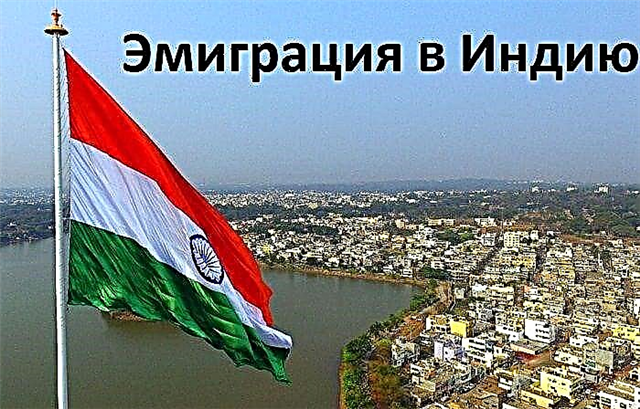India is one of the most underrated regions for emigration. A huge country of contrasts with a billion people can show migrants both the magnificent beaches of Goa and cultural monuments, as well as slums near major cities. At the same time, even a few tourist trips can not always help to form the correct impression - too much is hidden "behind the screen", far from the standard routes.
A little about India
The country is located in the SEA region (Southeast Asia), almost entirely located on the Indian subcontinent and washed by the Indian Ocean.
A huge area of 3.28 million square kilometers (the seventh country in the world in size) is located in the tropical zone, due to which the year is divided into three seasons:
- Cool and dry with a northeasterly wind (November to February);
- Dry transition period lasting three months from March;
- The hot and humid season runs from June to October.
In the summer, the country turns into an “oven”, so it is not recommended to visit it in the third season. The most favorable time for the first visit is mid-April and New Year's holidays.

The level of industry and infrastructure varies greatly from region to region. It is important to realize right away that it will be very difficult to find work in Goa, Delhi, Jaipur, Mumbai, while industrial areas cannot boast of beautiful views and cleanliness. Migration to Goa will be a good option in case of remote work, business or other source of income not related to the place of residence.
India is an agricultural country, the sector employs more than half of the population, which provides about 20% of GDP. Food problems in the country have lasted throughout its history, so today, food self-sufficiency is still a key goal of every government in India.
The main crops are wheat, rice, corn. For sale abroad are grown:
- Tea;
- Coffee;
- Sugar cane;
- Tobacco;
- Cotton;
- Rape.

A significant income is brought by spices - a third of all world production is located in Hindustan. Animal husbandry is poorly developed due to cultural characteristics: the cow is sacred for the Hindus, while the pig is considered an unclean animal for most of the country's population. Cattle are used, as they have been for millennia, for the transport of goods.
Living standards range from dire poverty with cardboard houses to magnificent palaces, with both worlds being separated from each other by wooden fences. The average price for essential products is even higher than in Russia, which is why there are many beggars living in the country.
You May Also Like
The labor market is very overloaded, especially for migrants - due to government regulations, only locals are hired for low-paid jobs, and the number of vacancies for foreigners at labor exchanges is close to zero. For qualified foreign employees by invitation, things are a little easier, although here, too, the quota is 1% of the number of Indian employees.
Immigration to India
Active migration is slowed down by the Hindu government - if it is incredibly easy to get a visa for long-term residence in the country, then the next step of obtaining citizenship will be much more difficult. Such a policy towards migrants is associated with overpopulation of the country - official statistics say, that in 2021 India is home to 1.2 billion people.
Indians have no problem with cheap labor or mid-level specialists, they need investments and high-class professionals. Bureaucracy only creates additional complications.
Many people who have moved for the first time live on the so-called "religious" visa. Indian law is much more tolerant of those who come to the country to study religious practices or profess one of the many faiths.
To see the sights of one of the most ancient countries in the world, it is enough to get a temporary two-month visa, which is activated upon entering the country.
Those who want to leave for the winter in Goa and other warm places can apply for a tourist visa for six months.

In general, migrants should understand that they are going to an overpopulated country with rather low average earnings per person. Expatriates to India are only accepted with open arms if they have unique skills or a good bank account.
How to move to India for permanent residence from Russia
So, after several visits to India, an enthusiastic tourist realizes that this is his country, and he is ready to meet old age in it. Where to begin?
You should start with obtaining a residence permit. Indian residence permit is of two types:
- Temporary;
- Constant.
You May Also Like
A residence permit is a transitional option between a tourist visa and citizenship. Temporary is valid for up to a year, permanent - indefinite with confirmation every five years.
To obtain a residence permit, you will need the following set of documents:
- International passport (+ copy of each page);
- Four color photos of a standard sample;
- Certificate of absence of an outstanding criminal record in the previous country;
- Valid Visa to India;
- A rental agreement or a document confirming the ownership of a living space;
- Statement from the account on which the not less than 2500 $. The bank must be a resident of India. In the case of family emigration, there must be an additional amount for each member at $ 1200;
- Description of the purposes and intentions of living in India.

You can get a residence permit and citizenship in a simplified way by fulfilling one or more of the requirements:
- Own business providing local people with jobs... The possibility of organizing such a business will be carefully considered by Indian officials; a business plan will need to be coordinated with the representative office of the Indian Ministry of Economy. If the plan is successfully completed, the residence permit will be extended to an indefinite period or converted to citizenship with minimal red tape.
- Investments. As in almost any country, large investments can become a stepping stone to obtaining a residence permit and citizenship. In India, you will need to invest an amount of one and a half million dollars for a period of at least five years.
- Marriage to a citizen of the country. A relatively quick and easy way, if you do not take into account the cultural characteristics of the Indians. There are fewer men of reproductive age in the country than women, and problems of compatibility with caste and social status make marriage a non-trivial task. You will have to live in marriage for at least three years: in the first year, a foreigner will receive the status of a temporary resident, two more years before obtaining citizenship will have to be content with a residence permit. The Indian authorities have a very bad attitude towards fictitious marriages, so it is not worth resorting to this method.
- Official work. For high-level specialists, the host side takes care of most of the questions. In this case, the migrant must have a contract with the working conditions and the duration of the agreement. The disadvantage of this option is the inability to change jobs without losing a visa until the migrant receives a full-fledged residence permit.
- Foreign training. If the desire to stay in India appeared from a young age, a fairly simple way to obtain citizenship would be to study at one of the accredited universities. The student automatically receives a residence permit based on a certificate from the university about passing exams and the absence of absenteeism. If a specialist stays in India after training and gets a job, all the time spent at the university is counted in the period of permanent residence.
- Moving to the family. It is possible to emigrate to close relatives - for example, parents who left earlier. In this case, the relatives must have a confirmed citizenship for a period of more than five years, they must give guarantees for material and moral support for the repatriates.

In other cases, full citizenship can be counted on only after ten years of residence. Dual citizenship is impossible according to Indian laws, so the Russian will have to be abandoned.
To obtain Indian citizenship you should:
- Be “clean” before law enforcement;
- Have a steady source of income;
- Use the official languages of the country - English and Hindi;
- Know the culture and customs of India.
The decision itself will take a very long time - the Indian bureaucracy and corruption at the lower levels reaches unimaginable proportions. You should be patient and persistently deal with the issue, not letting it drift.
Life of Russians in India after the move
Let's start with the good news - there is a relatively large Russian diaspora in India. The country is home to both the “first wave” of descendants of migrants in 1917, who fled the chaos of the civil wave, and modern migrants who moved to India because of the relative cheapness of life and globalization.
In India, I was amazed by the attitude towards family, friends, neighbors. In addition to huge family trees up to four cousins, Hindus usually have a lot of friends and acquaintances. And if something happens, the whole street will come to the rescue. An incredible feeling.
Ivan, four years in Indian residence permit.
Modern "new Hindus" most often live in the status of delayed tourists or with a residence permit, not intending to acquire full-fledged citizenship. The country is most popular with people with remote work or regular income - prices outside the tourist areas here are strikingly low, and most of the population survives on the amount of 50 cents to two dollars a day.
Things are cheap. Too cheap, I mean. At first it was even a shame to give such a penny for the manual labor of a person opposite.
Svetlana, tourist, third visit to the country.
The middle class is quite saturated - about 200 million people, but compared to the rest of the population, this is practically a drop in the bucket. It is worth living either in large resort towns or on the coast: although prices are higher there, it will be much easier to meet a compatriot and find a relatively high-paying job.
After moving, the first couple of months I was just in shock. There are no normal shops, no roads, and only a couple of good buildings for the whole “city”! Over time, you get used to it, but beginners should know - outside of big cities and resorts, everything looks different than on travel brochures.
Alena is a citizen of India.
A significant part of the Russians who decided to move to the country either studied at a local university or married a local resident. There are international training programs based on the ITEC cooperation program. Russians can often be found on the staff of transcontinental companies and large corporations.
I heard a lot from friends about poverty, poverty, garbage ... well, and many more terrible words. I don’t know, maybe in the suburbs it’s true. But I myself have not seen anything like it, although I have been living in Delhi for the fifth year. There are cultural differences, laziness, unbearable summer heat and a lot of other things, but the country as a whole is great. Not once in three years did I regret accepting an invitation to work.
Sergey, database architect.
Conclusion
Having overcome a number of bureaucratic, cultural and social barriers, many migrants look around and instead of the golden beaches of Goa see poverty and devastation in the central regions of the country. India cannot be called an ideal or even a good country for life - the gaps in society are too great, the caste past puts pressure on the Hindus too much today.
Before choosing India as a place for permanent residence, you should weigh all the possible pros and cons. At the same time, it is imperative to have a stable third-party income or unique skills - without this it will be incredibly difficult to survive in a country that is already overcrowded.











